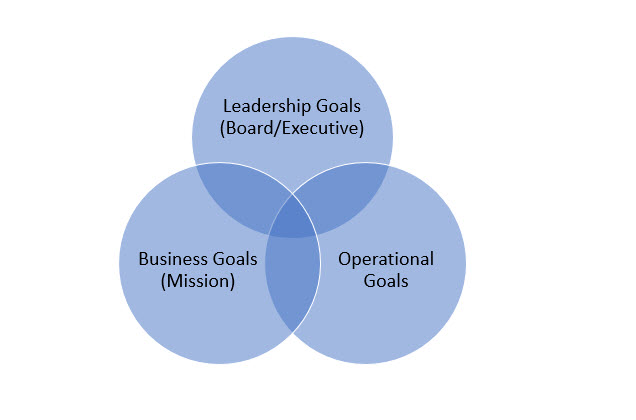This Simple Approach to Strategy Makes You a More Effective Executive

 A friend of mine is an avid mountain biker. He’s a big guy. A tough guy. Imagine the Incredible Hulk on a bicycle. Except not green. But probably the same intense, unhappy look on his face.
A friend of mine is an avid mountain biker. He’s a big guy. A tough guy. Imagine the Incredible Hulk on a bicycle. Except not green. But probably the same intense, unhappy look on his face.
He stands out in the skinny, biker-short wearing crowd. He doesn’t ride a bike. He challenges it to survive.
Some time ago, he showed me a video that he had made with his new GoPro camera. In the video you see that he is in the mountains, in the tundra, mostly above the tree-line, riding a narrow trail.
You can hear his breathing. In the distance, there is a lone tree. The only tree.
More breathing. More pedaling. The tree is getting closer.
And closer.
The tree, the only tree in sight, is near the side of the trail. It’s a straight trail. Not a technical trail.
SMACK!
There is a confused jumble. Now the camera is looking up at the sky. His language is colorful.
He ran into the tree.
The one thing he needed to avoid.
Why?
Because it was what he was focused on. Even though he didn’t intend to drive into the tree – it captured his attention. So, that’s what he did.
Where to focus when thinking about strategy
This is the time of year that many organizations are thinking about strategy. Successful executives and boards are starting to reflect on how this year went. They start to think ahead to what they would like to accomplish next year.
Setting strategy is primarily about answering the questions, “Where are we trying to go?” and “How do we get there?”
It becomes important to pay attention to where you are focusing as an organization. Because wherever you focus, wherever a leader’s head tends to turn is where an organization tends to go.
Your focus can suck you in. Make sure you are focusing on the right things.
Keep your eyes on the trail. Not on the tree.
The following process will help you create the focus.
The Three Strategic Spheres

Successful and vibrant organizations are healthy and focused in each of these three areas. When an organization struggles, it is nearly always in one or more of these areas.
For my friend, it was important to stay focused on the trail, potential obstacles as well as how he handled his bike. When he only focused on one, he lost perspective and crashed.
This is common for leadership teams – to lose situational awareness. To not know where to focus – and so focus on the one, wrong thing.
What are The Three Strategic Spheres?
Leadership: Board or ownership level and executive leadership. This is the most commonly neglected sphere when it comes to awareness or strategy. Despite this, the questions and interests that exist in this sphere are the primary drivers of most business decisions.
In the business world, this sphere is rarely addressed from a strategic perspective. The primary exception to this is when exploring partnerships, mergers, exit strategies or executive succession. However, those are infrequent occurrences for most businesses. Yet in these situations and in the normal day-to-day, there is usually a lack of strategic thought around leadership.
In the non-profit or public institution world, this leadership sphere is nearly always neglected as well. This is usually because of a lack of awareness that this sphere matters as much as it does. Additionally, it takes far more effort to build up a non-profit board – usually run by volunteers. Yet an organization with a low-performing board or executive will always accomplish less than it could.
Operational: Resources (cash flow, staffing, facilities) and processes (hiring, marketing, quality control.)
Operations in an organization are analogous to the mechanics and electrical systems of your vehicle.
When everything is maintained and running well, it takes very little and usually planned-for maintenance to keep it running well. However, when they are not maintained or running well, it can become very expensive, time-consuming and frustrating to focus on.
Despite this, many vehicle owners neglect the routine maintenance. Or they ignore the signs of problems. Their problems and costs expand.
Organizations, whether businesses or non-profits that neglect developing an Operational strategy will often find themselves bottle-necked without the staff they need to provide services or without the cash flow to take advantage of opportunities or without the buffer they need to weather a challenging time.
New businesses often struggle to learn how to manage operations well. Mature businesses have usually figured it out. Their missing question is usually, “Does the structure we’ve created serve us as we pursue growth?” They, often, wrongly assume that the same structure will work for all stages of growth.
Large or mature non-profits can over-focus on operational health to the point of neglecting their mission (below). In many cases, the tail starts to wag the dog as they’ve built an infrastructure that demands being fed.
Smaller or younger non-profits will more likely neglect their operational health with the misinformed belief that “mission trumps all.” That belief is why they are nearly always smaller or younger.
Business (or Mission) Goals: What is the purpose that this organization is pursuing? What are the goals that justify the effort and investment into the organization – whether business or non-profit?
In business, this often seems straight-forward. The purpose is profit.
However, in most cases, this isn’t the whole answer. Especially with owners of small and mid-sized companies.
They tend to view their business as their retirement investment – but don’t plan accordingly.
They often have a quality of life goals they want to pursue. Many owners are literally living out their answer to the question, “If I could do things my way…” and they want to realize their dreams of an ideal workplace – for themselves and their employees.
Despite media portrayals, many businesses genuinely want to have positive, social impact on their communities.
These are all goal types, which could be strategic, but are often forgotten.
For non-profits, this would also seem straightforward. However, challenges related to funding can pull many non-profits away from their core mission.
It is a common challenge for (usually larger or more mature) non-profits to have become effective at obtaining funding. And then not being able or willing to make needed mission-driven pivots to strategy or approach.
The Four Questions
When I work with clients, I often ask these four questions around each of The Three Strategic Spheres:
What’s working? This identifies strengths you want to keep, preserve or expand on.
What’s not working? This identifies opportunities for improvement or change.
What is confused? This identifies where clarity needs to be established.
What is missing? This identifies what needs to be added or clarifies what you are not yet ready to pursue.
Aspirational Goals & Operational Goals
In each of these areas you’ll find that your goals break into two different types:
Aspirational Goals are goals that you are moving toward. These are the classic, visionary goals that organizations set.
Operational Goals are the goals that you need to maintain. These can often be lost or forgotten in the excitement of developing a new vision. However, if these goals are dropped, you’ll often find it difficult to obtain your Aspirational Goals.
Think about it like this: The family is heading on a road trip.
Aspirational goals may include: The destination, having fun along the way, relaxing and everybody getting along.
Operational goals may include: Planning stops for gas and rest breaks, deciding whether to pack meals or stop along the way, checking in with that one client issue that couldn’t be delayed.
You need both. The operational goals, on their own, don’t provide much of a family experience. However, if you don’t pay attention to them, you risk not realizing your aspirations.
Balanced Strategy
By developing a more balanced approach to developing strategy you’ll find that you are more likely to use it.
If you are looking at strategy work this year, what are areas that your organization does well in?
What are areas that you may want to strengthen?
Take good care,
Christian
P.S. Would you like to talk to me, one-on-one, about how you can help your team develop a focused and unifying strategy? Or perhaps you’d like to rapidly develop ideal leadership behaviors or habits?
My clients tell me that engaging me helped them add between $120K and $1M in new, annual revenue or savings, usually within 12 months. Contact me to learn more: christian@vantageconsulting.org or 907 522-7200.
Article Categories
Popular articles

Download my free 10-page eBook:
How To Accomplish More Without Doing More:
Eight Proven Strategies To Change Your Life
Discover how to save eight hours during your workweek-even if you're too busy to even think about it. The resource every maxed out executive needs.